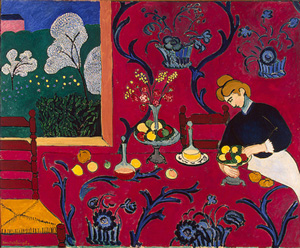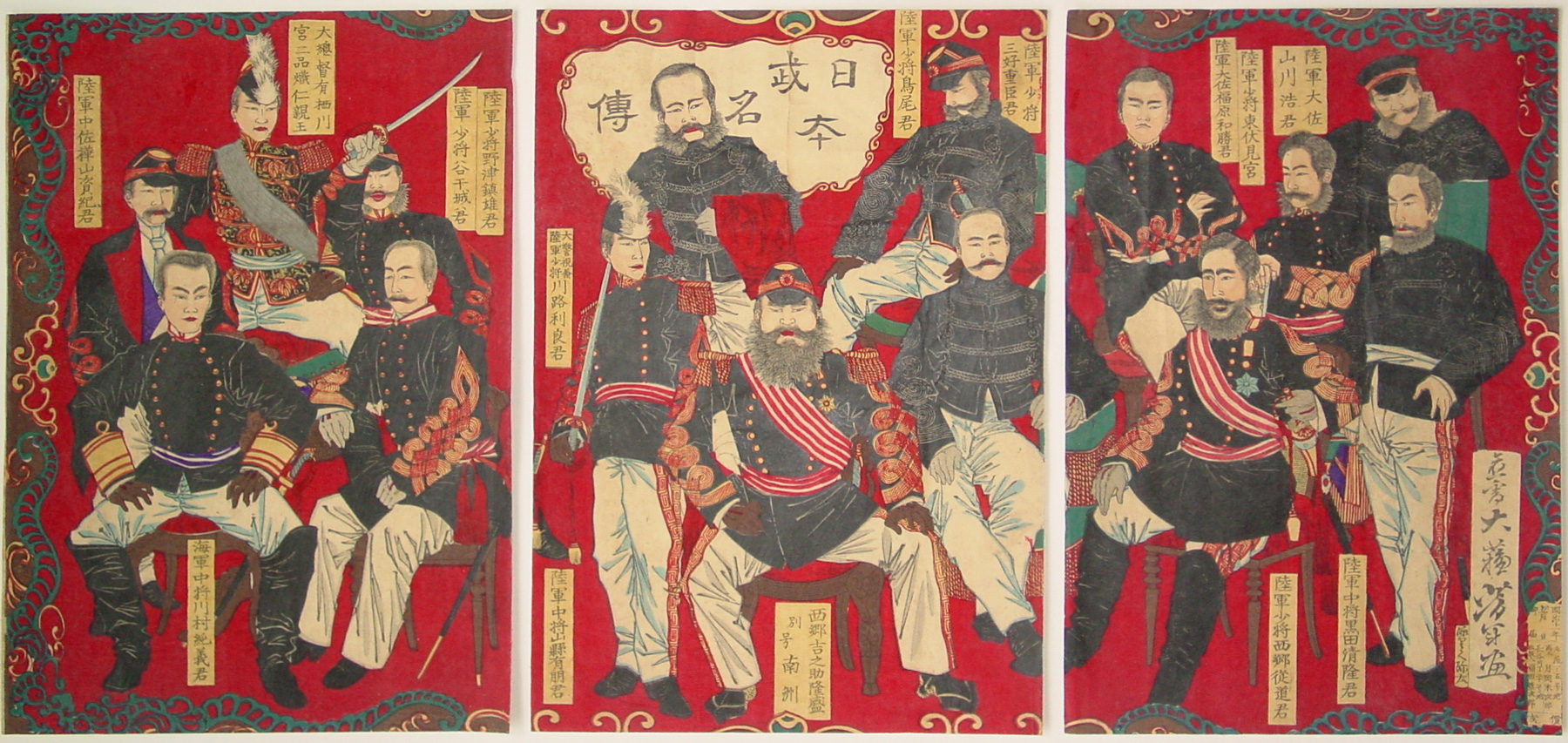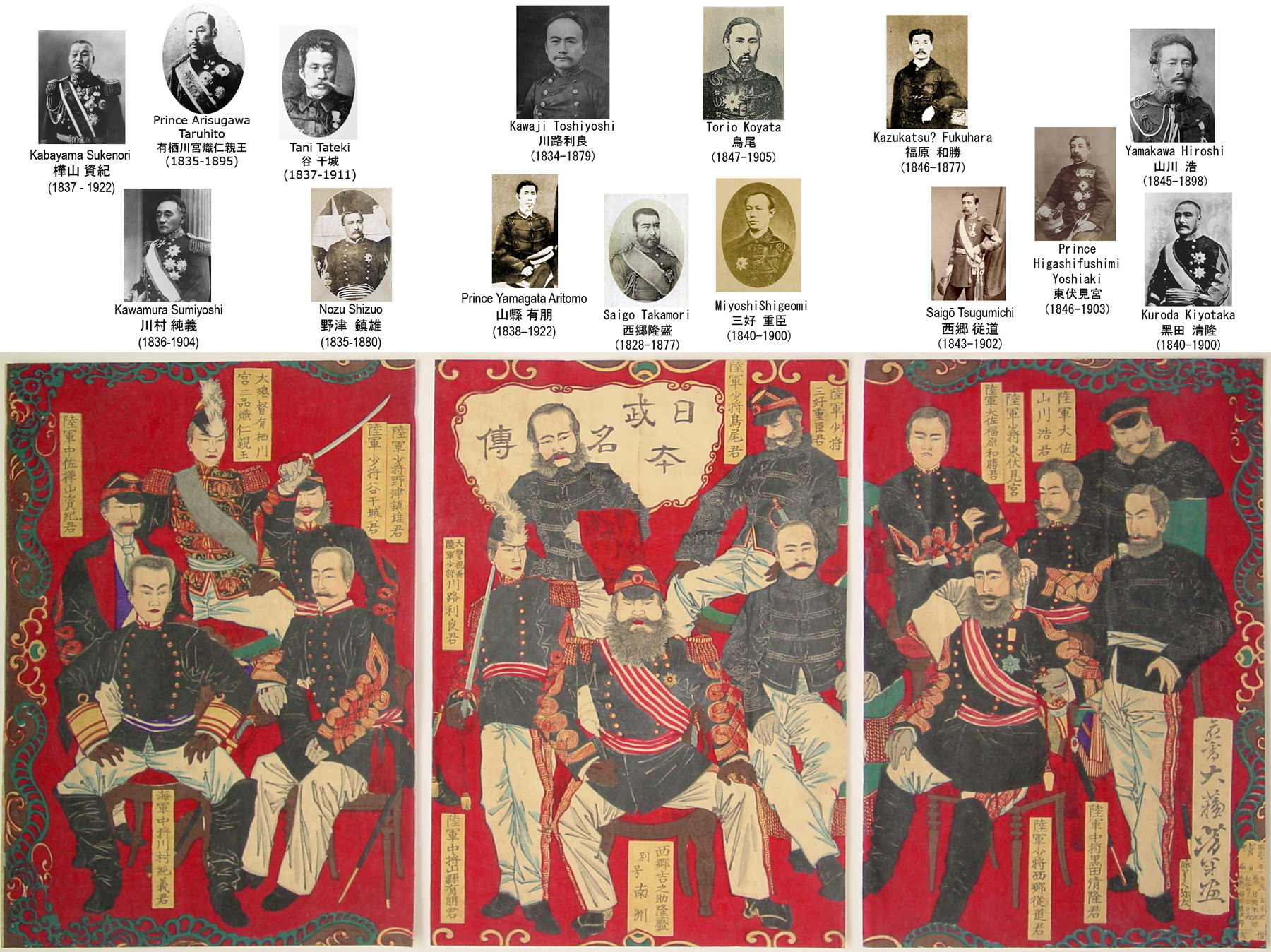About This Print
Source: Courage and Silence: A Study of the Life and Color Woodblock Prints of Tsukioka Yoshitoshi: 1839-1892, Roger Keyes, 1982, p. 180.
 The Red Room (Harmony in Red) 1908 Henri Matisse | In commenting on this print Roger Keyes states “Most of the aka-e, or red prints, were revolting, but the same colors could produce great beauty when the subject touched the artist’s nobler feelings. The aniline red that Yoshitoshi used for this picture of General Saigo and the other heroes of the Satsuma Rebellion is as striking and effective as the background of the Red Room of Matisse. The portraits seem quite individual and were probably recognizable likenesses. Perhaps this was one of three or four prints that the government commissioned Yoshitoshi to design for display in foreign exhibitions. The artist took these commissions very seriously and spent considerable time on their execution. Yoshitoshi’s drawing had often been tentative and broad; like Daumier, he enjoyed exaggeration and expressive distortions more than literal likeness and detailed renderings. But there was also pleasure in drawing with a finer brush and greater delicacy. The faces of the officers are quite distinct and individual, and Yoshitoshi may have drawn them from life, or from photographs." |
A Few Personal Comments on Keyes' Commentary:
To my eye Yoshitoshi's renderings of these 15 men are a bit stiff. In many of the portraits the heads seem stuck on to the bodies. Perhaps several carvers were involved causing this strange effect. As to the likenesses of the portraits, I've located photographs or period renderings of all the subjects and there are definite likenesses between some of the photos and Yoshitoshi's drawings. (See composited print with photos below.)
The Fifteen Soldiers
Front and center in the center panel is the seated Saigo Takamori (1827-1877), leader of the ill-fated 1877 Satsuma Rebellion. All of the figures surrounding Saigo played a role in suppressing the Rebellion and by the time this print was released, Saigo was eight months dead, a popular hero and in process of being rehabilitated by the Meiji government he rebelled against. Saigo is pictured in his Field Marshall's uniform, the military rank he achieved prior to resigning his government position.
LEFT PANEL:
center top - Prince Arisugawa Taruhito 有栖川宮熾仁親王 (1835–1895)
Source: wikipedia http://en.wikipedia.org/wiki/Prince_Arisugawa_Taruhito
In 1867, Emperor Meiji appointed Prince Arisugawa sōsai (a title equivalent to chief minister), and placed him in command of the Imperial Army sent against the last partisans of the Tokugawa bakufu in the Boshin War of 1868-1869. Prince Arisugawa later led the central government army against the forces of Saigo Takamori in the Satsuma Rebellion of 1877. He was given the honorary rank of general in 1878. From 1870 until the adoption of the Cabinet system in 1885, Prince Arisugawa served as Daijō Daijin or lord president of the Council of State. From 1889 to 1895, the prince served as chief of staff of the Imperial Japanese Army and a member of the Supreme War Council.
upper left - Kabayama Sukenori 樺山 資紀 (1837-1922)
Source: National Diet Library http://www.ndl.go.jp/portrait/e/datas/58.html?c=7
Born in Kagoshima, the son of a samurai of the Kagoshima Clan. He served in the Anglo-Satsuma War and the Boshin War. In 1871, he was appointed an army major. He served in the Taiwan Expedition. During the Satsuma Rebellion, he took an active part as chief of staff in Kumamoto District. He became chief of the Imperial Staff, Superintendent-General of the Metropolitan Police Department and an army major general. In 1874 he switched to navy, becoming taifu (senior vice minister) of Navy in 1883 and vice navy minister in 1886. In addition, he served as navy minister in the first Yamagata and the first Matsukata cabinets. His speech made during the second Diet session, the so-called "Ban'yu Enzetsu" (speech with brute courage) aroused criticism. During the Sino-Japanese War, he served as chief of the Naval General Staff Office. In 1895, he became an admiral and the first governor-general of Taiwan. Later, he held important posts including privy councillor, home minister in the second Matsukata cabinet, and education minister in the second Yamagata cabinet.
upper right (with raised sword) - Tani Tateki 谷 干城 (1837-1911)
Source: National Diet Library http://www.ndl.go.jp/portrait/e/datas/131.html
Born in Kochi as the son of a samurai of the Kochi Clan. Under the influence of Zuizan Takechi, he joined the sonno joi undo (movement to revere the emperor and expel the barbarians) and exerted great efforts to bring about the coalition between Satsuma and Tosa. He served in the Boshin War as daigunkan (senior commander). In 1871, he became an officer of Army-Navy Ministry and was appointed a colonel. In 1873, he became commander-in-chief of the Kumamoto District. In the following year, he was involved in the subduing of the Saga Rebellion, and served in the Taiwan Expedition. In 1876, he was again appointed commander-in-chief of the Kumamoto District, and during the Satsuma Rebellion he put up a stubborn defense of Kumamoto Castle. After serving as commandant of the Military Academy and other posts, he became president of the Gakushuin in 1884. In addition, he served as agriculture and commerce minister in the first Ito cabinet. After a study tour of Europe, he stood opposed to the government's westernizing policy and treaty revision, and resigned from the post. In 1890, he became a shishaku (viscount) member of the House of Peers. Jointly with Goro Miura and others, he strongly opposed the clan clique (han-batsu) government and advocated a tough foreign policy.
lower left - Kawamura Sumiyoshi 川村 純義 (1836-1904)
Sources: National Diet Library http://www.ndl.go.jp/portrait/e/datas/63.html?c=8 and wikipedia http://en.wikipedia.org/wiki/Kawamura_Sumiyoshi
Naval officer. Born in Kagoshima. During the Boshin War, he distinguished himself as a samurai in land warfare, but when the Navy Ministry was established in 1872, he became taifu (senior vice minister) of Navy. During the Satsuma Rebellion, he was placed in command of all Imperial troops in September 1877 at the final Battle of Shiroyama near Kumamoto, when Saigō Takamori was killed (or committed seppuku.) In 1878, he became sangi (councillor) and the second navy minister. He remained in that position until 1885 except when he was temporarily replaced by Takeaki Enomoto, and during that period he expanded the Satsuma forces in the navy. In 1884, he received the title of hakushaku (count). Later serving as court councillor and privy councillor, in 1901 he was given responsibility for the upbringing of the newborn who was to become the Showa Emperor. In 1904, he was posthumously appointed a admiral, the first time this was done.
lower right - Nozu Shizuo 野津 鎮雄 (1835-1880)
Held the rank of Major General heading the newly organized 1st brigade which fought against Saigo during the Satsuma Rebellion.
CENTER PANEL:
center (seated figure) - Saigo Takamori 西郷隆盛 (1827-1877)
Source: National Diet Library http://www.ndl.go.jp/portrait/e/datas/85.html?c=0
Leader of the Meiji Restoration; statesman. Born in Kagoshima. Holding high office under the Kagoshima Clan lord Nariakira Shimazu, he tried to commit suicide by drowning on the occasion of the Ansei Purge and the death of Nariakira. Later he was active under Hisamitsu Shimazu, who aimed at kobu gattai (the reconciliation between the Imperial Court and the Shogunate government), but because of a conflict with Hisamitsu he was exiled. When recalled, he took an active part as staff officer on the side of the Shogunate government on its first Choshu expedition. Later he changed allegiance to oppose the Shogunate government, and concluded the Satsuma-Choshu Alliance with Takayoshi Kido through the intermediation of Ryoma Sakamoto. Jointly with Kaishu Katsu, he achieved the bloodless surrender of Edo Castle and successfully conducted the coup d'etat of osei fukko (restoration of Imperial rule). As a sangi (councillor) in the new government, he pushed through reforms. In 1873, he lost in the Seikanron (conquer Korea debate) and resigned from the government. In 1877, urged by students of his private school in his home town, he raised an army causing the Satsuma Rebellion, but he was defeated by the government army and committed suicide.
upper left - Kawaji Toshiyoshi 川路 利良 (1834-1879)
Sources: Police and Community in Japan, Walter L. Ames, University of California Press, 1981, p. 9-10
Kawaji Toshiyoshi, a former samurai from Kagoshima, was sent to Europe in 1872 to study police systems. On his return he recommended a series of measure for police reorganization that were heavily influenced by France and Prussia. The result was the establishment of the Home Ministry (Naimusho) in 1873, which directly controlled prefectural administrations by appointing governors. It also controlled the police through the police bureau (keishikyoku, later keihokyoku) under its jurisdiction, although routine management of police activities was handled at the prefectural level. The Tokyo Metropolitan Police Department (Keishicho), the police force in the capital, was organized in 1874 with Kawaji as head.
He was a friend of Saigo Takamori but stayed loyal to the government during the rebellion. He was accused by Saigo’s supporters of plotting his assassination. Kawaji, who held the rank of General, led troops against Saigo’s rebels.
upper right - Torio Koyata 鳥尾 (1847-1905)
Source: Political Waves in the Zen Sea: The Engaku-ji Circle in Early Meiji Japan," Janine Anderson Sawada, appearing in Japanese Journal of Religious Studies 1998 25/1–2 http://nirc.nanzan-u.ac.jp/publications/jjrs/pdf/514.pdf
Son of a Hagi samurai, Torio would become a well-known military man, political figure, educator, and writer in the Meiji period. He fought, at the age of sixteen, alongside the domain riflemen at Shimonoseki when Chõshð shelled U.S. and French ships in 1863, and distinguished himself as a troop commander in various skirmishes against the shogunate during its last years. His unit of twenty men, called Torio-tai, became the new Meiji government’s advance guard in the 1868 pacification of rebellious shogunal troops. Meanwhile, he was appointed to the new Ministry of Military Affairs and quickly rose through a succession of appointments to become (in 1876) a general of the second rank and chief of army staff. During the Seinan War of 1877, Torio was a central figure in the planning of maneuvers against Saigõ Takamori’s troops. But by early 1878, according to his own account, he felt he had fulfilled his mission on the battlefield and privately decided to resign his military commission. He hung on until 1880, by which time he had risen to the position of general in the Imperial Guard.
lower left - Prince Yamagata Aritomo 山縣 有朋 (1838–1922)
Source: National Diet Library http://www.ndl.go.jp/portrait/e/datas/208.html?c=2
Military officer and statesman. Born in Yamaguchi as the son of a samurai of the Hagi Clan. He studied at the Shoka Sonjuku, and was active as superintendent of the Kiheitai (irregular militia). He fought in the Boshin War. After serving as taifu (senior vice minister) of Army-Navy Ministry, and army taifu, he became war minister in 1873. Promoting conscription, he focused on building the military system. He commanded the imperial troops that fought against Saigo Takamori in the Satsuma Rebellion. He became chief of the General Staff Office in 1878, home minister in 1883, and home minister in the first Ito cabinet in 1885. While suppressing the people's rights movement, he focused on establishing a centralized local government system. In 1889, he formed the first Yamagata cabinet, and successively held important posts including justice minister, war minister in the second Ito cabinet, chairman of the Privy Council, and commander of the First Army during the Sino-Japanese War. In 1898, he formed his second cabinet. During the Russo-Japanese War, he commanded operations as chief of the General Staff. As genro (elder statesman), he effectively gathered government officials and military men, into what was called the "Yamagata-batsu (clique)," and exerted major influence on the political establishment.
lower right - Miyoshi Shigeomi 三好 重臣 (1840-1900)
Commander of the 2nd? brigade who fought against Saigo. Promoted to Lieutenant General in 1880.
RIGHT PANEL:
center - Prince Higashifushimi Yoshiaki 少将 東伏見宮 (1846-1903)
Sources: wikipedia http://en.wikipedia.org/wiki/Prince_Komatsu_Akihito and as footnoted.
Prince Yoshiaki was the seventh son of Prince Fushimi Kuniye. In 1858, he was adopted by Emperor Ninko as a potiental heir to the throne. As he was born when the country was still under rule by the Tokugawa Bakufu, he was sent into the Buddhist priesthood. He returned to secular life in 1867 during the Meiji Restoration, and led imperial forces during the Boshin War to overthrow the Tokugawa shogunate. (Keene states in his definitive biography of Emperor Meiji that "Prince Yoshiaki was a strange choice as the commanding general...as he had no qualifications for the post"1 at that time, though he was to later study military tactics in England from 1870-1872.) In 1870, Emperor Meiji assigned him the title of Higashifushimi-no-miya.
In 1882, he changed the name of his house to Komatsu-no-miya and his personal name from “Yoshiaki” to “Akihito”, and became therefore known as "Prince Komatsu-no-miya Akihito".
Prince Komatsu rose to the rank of general and received command of the First Imperial Guard Division in 1890. He was nominal commander of the Japanese expeditionary forces in the First Sino-Japanese War (1894–95) and became a member of the Supreme Military Council. Following the death of his uncle, Prince Arisugawa Taruhito in 1895, Prince Komatsu Akihito became the chief of the Imperial Japanese Army General Staff, and received the honorary rank of field marshal.
1 Emperor of Japan: Meiji and His World, 1852-1912, Donald Keene, Columbia University Press, 2002, p. 126.upper left - Kazukatsu? Fukuhara 福原 和勝 (1846-1877)
upper right - Yamakawa Hiroshi 山川 浩 (1845-1898)
Source: wikipedia http://en.wikipedia.org/wiki/Yamakawa_Hiroshi
A samurai of late Edo period Japan who went on to become a noted general in the early Meiji period Imperial Japanese Army. An Aizu retainer famous for his ingenious strategies against the early Meiji government during the Boshin War to overthrow the Tokuga wa bakufu, he was of the first people from Aizu to write a history of the years leading up to the war, together with his brother Yamakawa Kenjirō. As a lieutenant colonel he served in the Satsuma Rebellion as a staff officer of the “2nd Independent Brigade,” and was trapped in Kumamoto Castle by the Satsuma forces, where he saved the life of Tani Tateki. For his actions there he was promoted to colonel in 1880, and soon after, to major general.
bottom left - Saigō Tsugumichi 西郷 従道 (1843–1902)
Source: National Diet Library http://www.ndl.go.jp/portrait/e/datas/86.html?c=7
Military officer, statesman, and later genro (elder statesman). Born in Kagoshima, the son of a samurai of the Kagoshima Clan. Influenced by his elder brother Takamori, he took part in the sonno joi undo (movement to revere the emperor and expel the barbarians). After serving in the Boshin War, he started to work for the new government. In 1874, he commanded the Taiwan Expedition as an lieutenant general. During the Satsuma Rebellion, he did not join his brother Takamori but remained on the side of the government. He successively held ministerial posts as education, war and agriculture and commerce minister. In 1885, when the cabinet system was adopted, he became the navy minister in the first Ito cabinet. In 1894, he became an admiral. He served in the Sino-Japanese War as navy minister, and in the following year received the title of koshaku (marquis) in recognition of his distinguished services during the war. In 1898, he became a fleet admiral. Serving as the navy minister for 10 years in total, he focused on the development and reform of the navy.
bottom right - Kuroda Kiyotaka 黑田 清隆 (1840-1900)
Source: National Diet Library http://www.ndl.go.jp/portrait/e/datas/71.html?c=0
Statesman, later becoming a genro (elder statesman). Born in Kagoshima, the son of a samurai of the Kagoshima Clan. He contributed to the establishment of the Satsuma-Choshu Alliance. During the Boshin War, he commanded at the Battle of Goryokaku and spared the life of the enemy general Takeaki Enomoto. After the Meiji Restoration, he engaged in the management of Hokkaido, serving as vice-director-general of the Hokkaido Development Agency and later its director-general, establishing Sapporo Agricultural College and introducing the system of setting soldiers on the land. In 1876, he concluded the Japan-Korea Treaty of Amity as ambassador extraordinary and plenipotentiary. In 1877, he was sent as part of the force to suppress the Satsuma Rebellion. After serving as agriculture and commerce minister in the first Ito cabinet, he became prime minister and attended the promulgation ceremony of the Constitution of the Empire of Japan. Later he became a privy councillor, and then chairman of the Privy Council.
Print Details
| IHL Catalog | #508 |
| Title | Famous Soldiers of Japan (Nihon bumei den 日本 武名 伝図) |
| Series | |
| Artist | Tsukioka Yoshitoshi (1839-1892) |
| Signature |  |
| Seal | none |
| Date | May 1878 (see below) |
| Publisher |  |
| Carver |  |
| Impression | excellent |
| Colors | excellent |
| Condition | good - trimmed to image, not backed, minor wrinkling |
| Genre | ukiyo-e; rekishi-e |
| Miscellaneous | |
| Format | horizontal oban triptych |
| H x W Paper | 9 3/4 x 14 in. (23.4 x 35.6 cm) each sheet |
| Collections This Print | |
| Reference Literature | Courage and Silence: A Study of the Life and Color Woodblock Prints of Tsukioka Yoshitoshi: 1839-1952, Roger Start Keyes, 1982, p. 180, pl. 33. |



